
Giorgio FerroAnse volanti, 1952
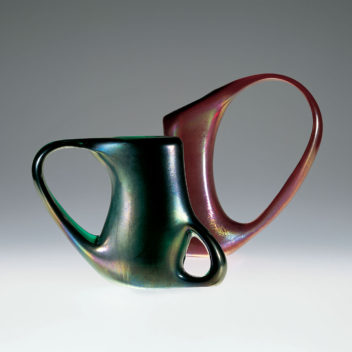
Giorgio FerroAnse volantiA.VE.M., 1952
Glass vessels, one crafted with the use of red trasparente glass, the other in green trasparente glass. Both are heavily iridized. They are typified by their large side handles made by piercing the wall of
the object.
7 1/2 in. high (19 cm)
10 1/2 in. high (26.7 cm)
Exhibitions:
1952, Venice, 26th Biennale Internazionale d’Arte;
2000, New York, Venetian Glass, Museum of Arts & Design;
2001, Milan, Murano: Vetri dalla Collezione Olnick Spanu, Spazio Oberdan.
Bibliography and comparative texts:
B. Nerozzi, 1987, n. 53;
W. Neuwirth, 1987, n. 231;
M. Heiremans, 1989, nn. 3-5;
L’arte del vetro…, 1992, n. 376;
R. Barovier Mentasti, 1992, n. 95;
M. Barovier, R. Barovier Mentasti, A. Dorigato, 1995, n. 90;
Venezia e la Biennale…, 1995, n. 469;
F. Deboni, 1996, p. 23;
H. Ricke, E. Schmitt, 1996, n. 172;
M. Barovier, 1999, p. 191;
Olnick Spanu, 2000, n. 106;
Olnick Spanu, 2001, n. 143;
A. Dorigato, 2002, p. 324.
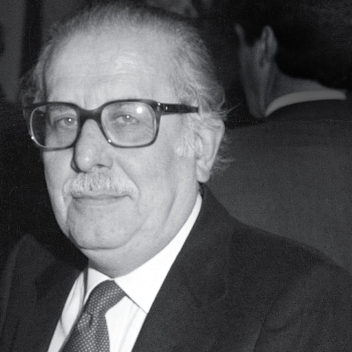
Giorgio Ferro 1931–
Born in Murano and the son of the glassmaker Galliano Ferro, Giorgio Ferro attended the Istituto d'Arte di Venezia, dedicating himself initially to painting. He soon went to work as a designer at the Vetreria A.VE.M. where his father had become a partner after the death of its artistic director Giulio Radi (1952). His most significant work of the period is a piece called Anse Volanti, dark colored vessels with iridescent surfaces and ample handles obtained hot directly from the body, which produces a remarkable sculptural effect. When his father, Galliano, left A.VE.M. in 1955 to found his own company, he followed him to become the artistic director of the new furnace, and designed thin blown pieces as well as essentially shaped encased glass pieces. He has been owner of Galliano Ferro since 1972.

A.VE.M. 1932–
A.VE.M. was founded in 1932 by Antonio Luigi Ferro, his son Egidio, and the maestri glassblowers Emilio Nason, Galliano Ferro, and Giulio Radi. During the '30s the furnace, which was capable of producing refined Venetian glass techniques, worked with Vittorio Zecchin, who created lightweight blown glass pieces, and Emilio Nason, who created Novecento-style sculptures. After 1939, Giulio Radi became artistic director and dedicated himself predominantly to experimenting with metal oxides. After Radi's premature death in 1952, Giorgio Ferro replaced him and acted as artistic director through 1955, the year he left to found a new furnace with his father, Galliano. During the '50s, A.VE.M. collaborated with the painter Luigi Scarpa Croce, and later the designer Anzolo Fuga. Between 1966 and 1972 several collections were designed by the glassmaster Luciano Ferro. A.VE.M. is still active in Murano today.
Giorgio FerroAnse volanti, 1952
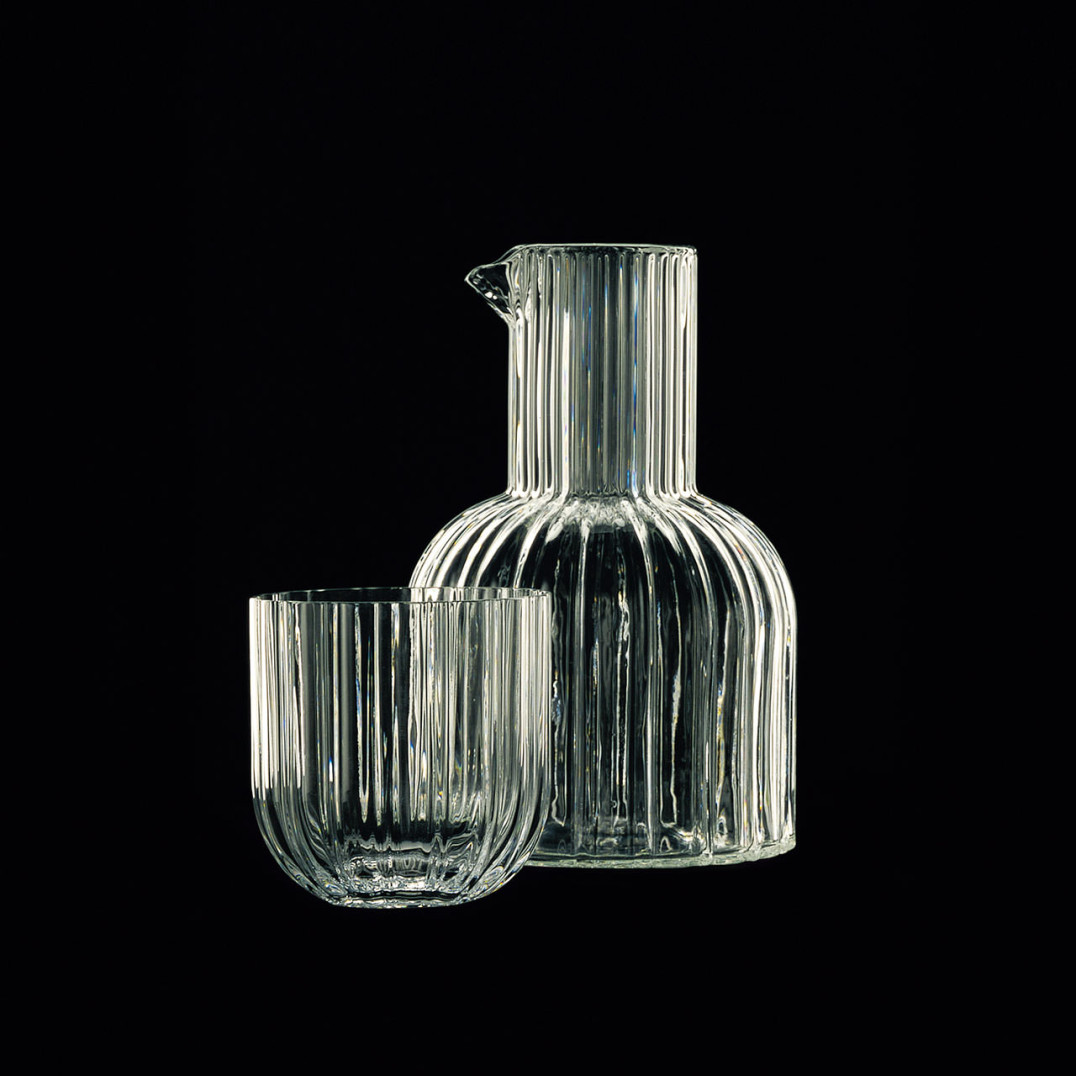
Massimo VignelliBicchiere e Brocca Ciga, 1979
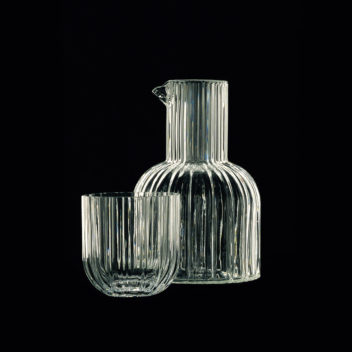
Massimo VignelliBicchiere e Brocca CigaVenini & C., 1979
Line of glassware designed by Massimo Vignelli and produced by Venini & C., for the Italian Ciga Hotels. The corrugation of the glass surface creates shadows and reflections and was designed to add brilliance and elegance to the glass.
3 1/2 in. high (8.9 cm)
7 1/8 in. high (18.1 cm)
Exhibitions:
2000, New York, Venetian Glass, Museum of Arts & Design;
2001, Milan, Murano: Vetri dalla Collezione Olnick Spanu, Spazio Oberdan.
Bibliography and comparative texts:
Design Vignelli, 1990, p. 272;
M. Romanelli, 2000, p. 210;
Olnick Spanu, 2000, n. 105;
Olnick Spanu, 2001, n. 142.
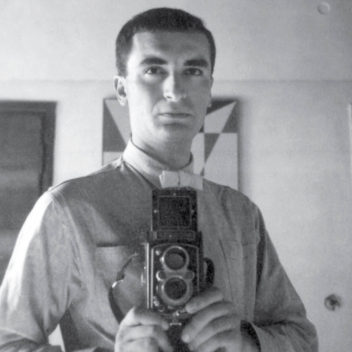
Massimo Vignelli 1931–2014
Massimo Vignelli studied architecture in Milan and Venice. While in Venice as a student, he worked for Venini from 1953 to 1957, designing lighting fixtures, glass windows, drinking glasses, and pitchers. Most of the pieces he designed are today in museum collections, notably the Museum of Modern Art and the Metropolitan Museum of Art in New York, the Musée des Arts Décoratifs in Montreal, Die Neue Sammlung in Munich, and others. A monographic exhibition of the Vignellis' work toured Europe between 1989 and 1993. Over the course of his career, Vignelli worked across the field of design, from graphic identity programs to publications, from products in glass, china, silver, and plastic to furniture and interiors. His work has been widely recognized by museums, publications and exhibitions throughout the world. Among Vignelli's impressive awards are the Gran Premio Triennale di Milano, 1964; Compasso d'Oro, 1964 and 1998; the AIA 1973 Industrial Arts Medal; the Art Directors Club 1982 Hall of Fame; the 1983 AIGA Gold Medal; the first Presidential Design Award; the Interior Design Hall of Fame, 1988; the National Arts Club Gold Medal for Design, 1991; the Interior Product Designers Fellowship of Excellence, 1992; and the Brooklyn Museum Design Award for Lifetime Achievement, 1995. He was awarded an Honorary Doctorate in Architecture from the University of Venice, Italy, and Honorary Doctorates in Fine Arts from Parsons School of Design, Pratt Institute, Rhode Island School of Design, and Corcoran School of Art. In 1996 he received the Honorary Royal Designer for Industry Award from the Royal Society of Arts, London.

Venini & C. 1932–2001
In 1932, when both Martinuzzi and Zecchin left the company, Paolo Venini changed the name from Vetri Soffiati Muranesi Venini & Co. (V.S.M. Venini & Co.) to Venini & C.. Milanese architect Tommaso Buzzi became the new artistic director. After 1934, artistic direction was taken on by Carlo Scarpa, who designed most of the company's production through 1947. Side by side with Venini, who often intervened personally in design, Scarpa created numerous collections of objects characterized by refined colors. After World War II, Venini & C. sought numerous collaborations with artists such as architect Giò Ponti and the Swedish-born Tyra Lundgren. After 1948, Fulvio Bianconi, Massimo Vignelli, and Tobia Scarpa contributed significantly to the new direction of the company. Paolo Venini died in 1959 and his son-in-law, Ludovico Diaz de Santillana, took over the management of Venini & C. He not only worked personally as a glass designer but also continued the collaboration started by Paolo Venini with various artists and designers. Starting in 1960, many other designers collaborated with the company, like Thomas Stearns, Toni Zuccheri, Tapio Wirkkala, Laura and Alessandro Diaz de Santillana, James Carpenter, Dan Dailey, Richard Marquis, Benjamin Moore, and Toots Zynsky. In 1986, the de Santillana family left the company, selling their stock to the Ferruzzi group, which guaranteed the fine quality Venini was known for by hiring new designers such as Timo Sarpaneva, Marco Zanini, Ettore Sottsass Jr., Alessandro Mendini, Mario Bellini, Barbara del Vicario, and others. In 1988, Venini was acquired by Royal Scandinavian. Since 2001, Venini S.p.A. has been part of Italian Luxury Industries Group and is led by Giancarlo Chimento, Giuliano Tabacchi, and Giorgio Rizzo.
Massimo VignelliBicchiere e Brocca Ciga, 1979
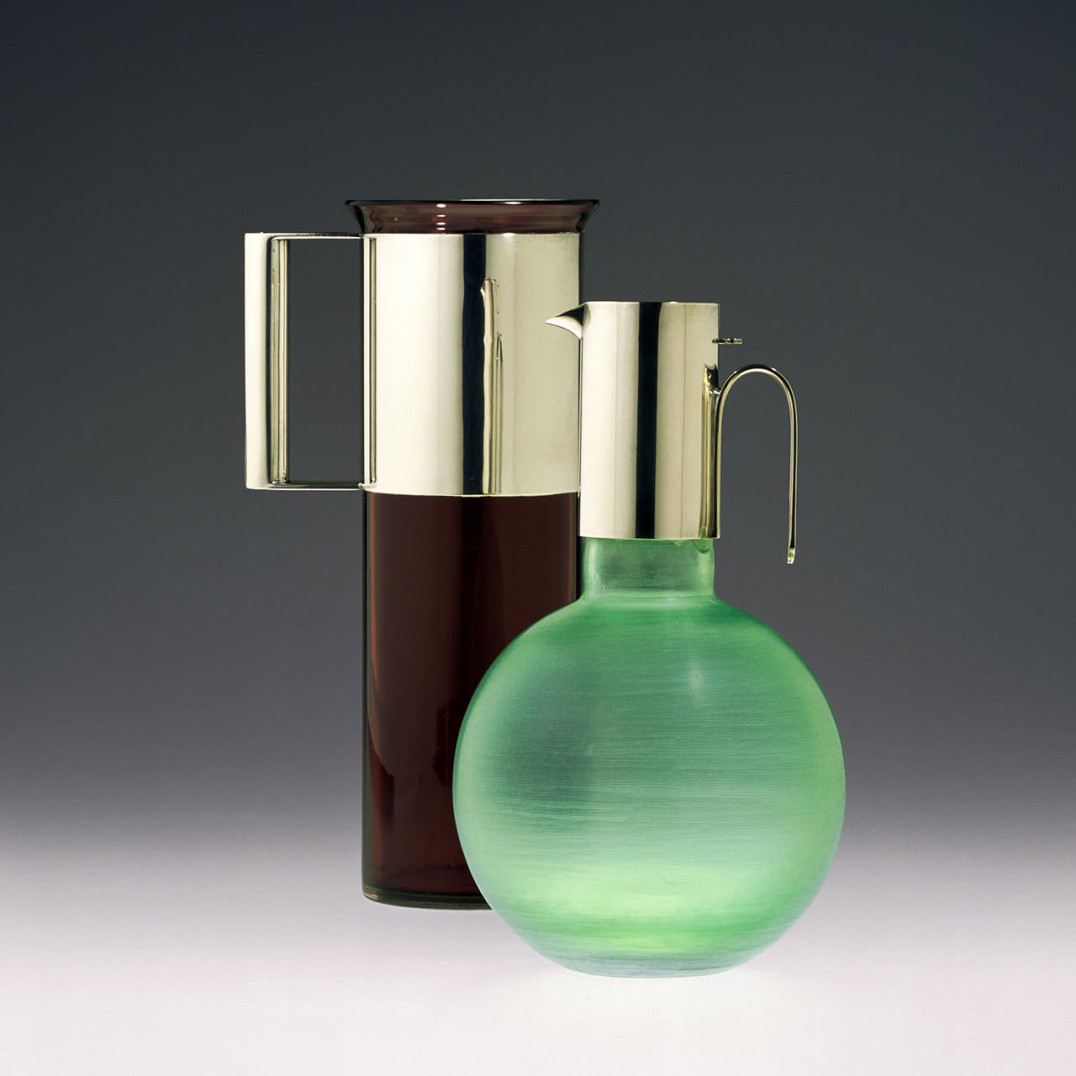
Massimo VignelliVetro e argento, 1957
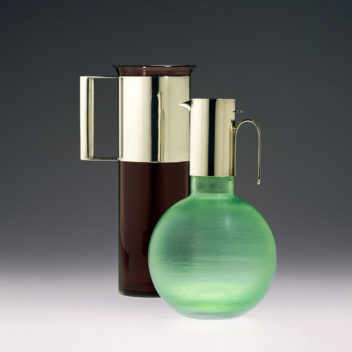
Massimo VignelliVetro e argentoVenini & C., 1957
Two transparent glass pitchers, one in aubergine and one in green glass, both finished with dense wheel-carved incisions. The two pitchers are fitted with a silver handle and a spout. This series was originally designed in 1957 for the American silversmith Towle but never produced. They were produced three years later, in 1960, by Venini & C., and the French silversmith Christofle.
11 7/8 in. high (cm. 30.2)
10 in. high (25.4 cm)
Exhibitions:
2000, New York, Venetian Glass, Museum of Arts & Design;
2001, Milan, Murano: Vetri dalla Collezione Olnick Spanu, Spazio Oberdan.
Bibliography and comparative texts:
Domus, 1963, July, pp. 39, 40;
Design Vignelli, 1990, p. 269;
A. Venini Diaz de Santillana, 1996, n. 214;
M. Romanelli, 2000, p. 210;
A. Venini Diaz de Santillana, 2000, n. 229;
Olnick Spanu, 2000, n. 104;
Olnick Spanu, 2001, n. 141.

Massimo Vignelli 1931–2014
Massimo Vignelli studied architecture in Milan and Venice. While in Venice as a student, he worked for Venini from 1953 to 1957, designing lighting fixtures, glass windows, drinking glasses, and pitchers. Most of the pieces he designed are today in museum collections, notably the Museum of Modern Art and the Metropolitan Museum of Art in New York, the Musée des Arts Décoratifs in Montreal, Die Neue Sammlung in Munich, and others. A monographic exhibition of the Vignellis' work toured Europe between 1989 and 1993. Over the course of his career, Vignelli worked across the field of design, from graphic identity programs to publications, from products in glass, china, silver, and plastic to furniture and interiors. His work has been widely recognized by museums, publications and exhibitions throughout the world. Among Vignelli's impressive awards are the Gran Premio Triennale di Milano, 1964; Compasso d'Oro, 1964 and 1998; the AIA 1973 Industrial Arts Medal; the Art Directors Club 1982 Hall of Fame; the 1983 AIGA Gold Medal; the first Presidential Design Award; the Interior Design Hall of Fame, 1988; the National Arts Club Gold Medal for Design, 1991; the Interior Product Designers Fellowship of Excellence, 1992; and the Brooklyn Museum Design Award for Lifetime Achievement, 1995. He was awarded an Honorary Doctorate in Architecture from the University of Venice, Italy, and Honorary Doctorates in Fine Arts from Parsons School of Design, Pratt Institute, Rhode Island School of Design, and Corcoran School of Art. In 1996 he received the Honorary Royal Designer for Industry Award from the Royal Society of Arts, London.

Venini & C. 1932–2001
In 1932, when both Martinuzzi and Zecchin left the company, Paolo Venini changed the name from Vetri Soffiati Muranesi Venini & Co. (V.S.M. Venini & Co.) to Venini & C.. Milanese architect Tommaso Buzzi became the new artistic director. After 1934, artistic direction was taken on by Carlo Scarpa, who designed most of the company's production through 1947. Side by side with Venini, who often intervened personally in design, Scarpa created numerous collections of objects characterized by refined colors. After World War II, Venini & C. sought numerous collaborations with artists such as architect Giò Ponti and the Swedish-born Tyra Lundgren. After 1948, Fulvio Bianconi, Massimo Vignelli, and Tobia Scarpa contributed significantly to the new direction of the company. Paolo Venini died in 1959 and his son-in-law, Ludovico Diaz de Santillana, took over the management of Venini & C. He not only worked personally as a glass designer but also continued the collaboration started by Paolo Venini with various artists and designers. Starting in 1960, many other designers collaborated with the company, like Thomas Stearns, Toni Zuccheri, Tapio Wirkkala, Laura and Alessandro Diaz de Santillana, James Carpenter, Dan Dailey, Richard Marquis, Benjamin Moore, and Toots Zynsky. In 1986, the de Santillana family left the company, selling their stock to the Ferruzzi group, which guaranteed the fine quality Venini was known for by hiring new designers such as Timo Sarpaneva, Marco Zanini, Ettore Sottsass Jr., Alessandro Mendini, Mario Bellini, Barbara del Vicario, and others. In 1988, Venini was acquired by Royal Scandinavian. Since 2001, Venini S.p.A. has been part of Italian Luxury Industries Group and is led by Giancarlo Chimento, Giuliano Tabacchi, and Giorgio Rizzo.
Massimo VignelliVetro e argento, 1957
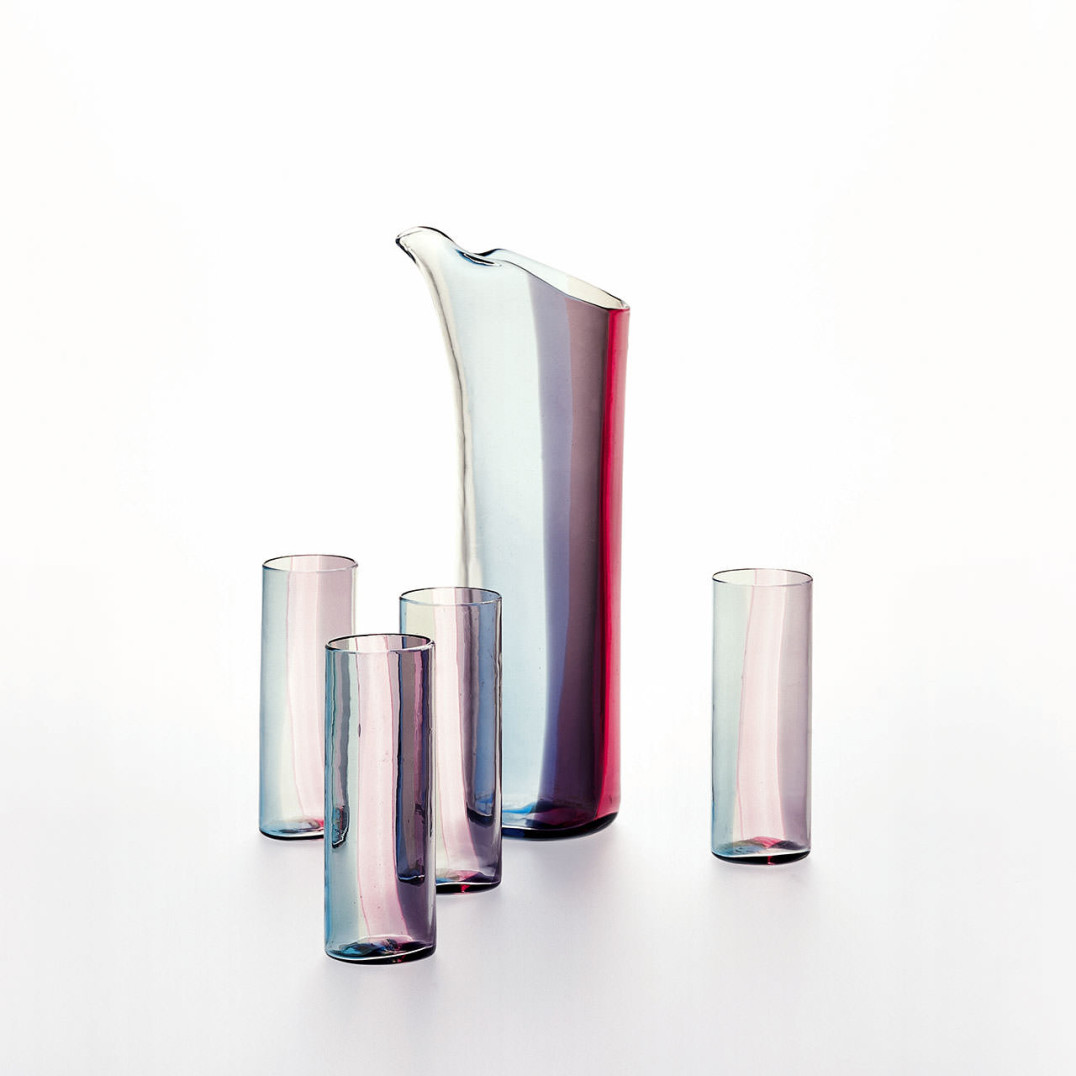
Massimo VignelliA fasce verticali, 1952
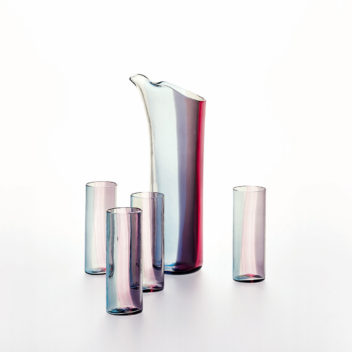
Massimo VignelliA fasce verticaliVenini & C., 1952
A pitcher and four drinking glasses crafted with transparent fasce verticali in pale colors.
Acid stamped:
venini murano.
5 15/16 in. high (15.1 cm)
13 3/16 in. high (33.5 cm)
Exhibitions:
2000, New York, Venetian Glass, Museum of Arts & Design;
2001, Milan, Murano: Vetri dalla Collezione Olnick Spanu, Spazio Oberdan.
Bibliography and comparative texts:
Venini, green catalogue, nn. 33c, 333.2;
F. Deboni, 1989, n. 113;
A. Venini Diaz de Santillana, 1996, n. 162;
M. Romanelli, 2000, p. 210;
A. Venini Diaz de Santillana, 2000, n. 226;
Olnick Spanu, 2000, n. 103;
Olnick Spanu, 2001, n. 140.

Massimo Vignelli 1931–2014
Massimo Vignelli studied architecture in Milan and Venice. While in Venice as a student, he worked for Venini from 1953 to 1957, designing lighting fixtures, glass windows, drinking glasses, and pitchers. Most of the pieces he designed are today in museum collections, notably the Museum of Modern Art and the Metropolitan Museum of Art in New York, the Musée des Arts Décoratifs in Montreal, Die Neue Sammlung in Munich, and others. A monographic exhibition of the Vignellis' work toured Europe between 1989 and 1993. Over the course of his career, Vignelli worked across the field of design, from graphic identity programs to publications, from products in glass, china, silver, and plastic to furniture and interiors. His work has been widely recognized by museums, publications and exhibitions throughout the world. Among Vignelli's impressive awards are the Gran Premio Triennale di Milano, 1964; Compasso d'Oro, 1964 and 1998; the AIA 1973 Industrial Arts Medal; the Art Directors Club 1982 Hall of Fame; the 1983 AIGA Gold Medal; the first Presidential Design Award; the Interior Design Hall of Fame, 1988; the National Arts Club Gold Medal for Design, 1991; the Interior Product Designers Fellowship of Excellence, 1992; and the Brooklyn Museum Design Award for Lifetime Achievement, 1995. He was awarded an Honorary Doctorate in Architecture from the University of Venice, Italy, and Honorary Doctorates in Fine Arts from Parsons School of Design, Pratt Institute, Rhode Island School of Design, and Corcoran School of Art. In 1996 he received the Honorary Royal Designer for Industry Award from the Royal Society of Arts, London.

Venini & C. 1932–2001
In 1932, when both Martinuzzi and Zecchin left the company, Paolo Venini changed the name from Vetri Soffiati Muranesi Venini & Co. (V.S.M. Venini & Co.) to Venini & C.. Milanese architect Tommaso Buzzi became the new artistic director. After 1934, artistic direction was taken on by Carlo Scarpa, who designed most of the company's production through 1947. Side by side with Venini, who often intervened personally in design, Scarpa created numerous collections of objects characterized by refined colors. After World War II, Venini & C. sought numerous collaborations with artists such as architect Giò Ponti and the Swedish-born Tyra Lundgren. After 1948, Fulvio Bianconi, Massimo Vignelli, and Tobia Scarpa contributed significantly to the new direction of the company. Paolo Venini died in 1959 and his son-in-law, Ludovico Diaz de Santillana, took over the management of Venini & C. He not only worked personally as a glass designer but also continued the collaboration started by Paolo Venini with various artists and designers. Starting in 1960, many other designers collaborated with the company, like Thomas Stearns, Toni Zuccheri, Tapio Wirkkala, Laura and Alessandro Diaz de Santillana, James Carpenter, Dan Dailey, Richard Marquis, Benjamin Moore, and Toots Zynsky. In 1986, the de Santillana family left the company, selling their stock to the Ferruzzi group, which guaranteed the fine quality Venini was known for by hiring new designers such as Timo Sarpaneva, Marco Zanini, Ettore Sottsass Jr., Alessandro Mendini, Mario Bellini, Barbara del Vicario, and others. In 1988, Venini was acquired by Royal Scandinavian. Since 2001, Venini S.p.A. has been part of Italian Luxury Industries Group and is led by Giancarlo Chimento, Giuliano Tabacchi, and Giorgio Rizzo.
Massimo VignelliA fasce verticali, 1952
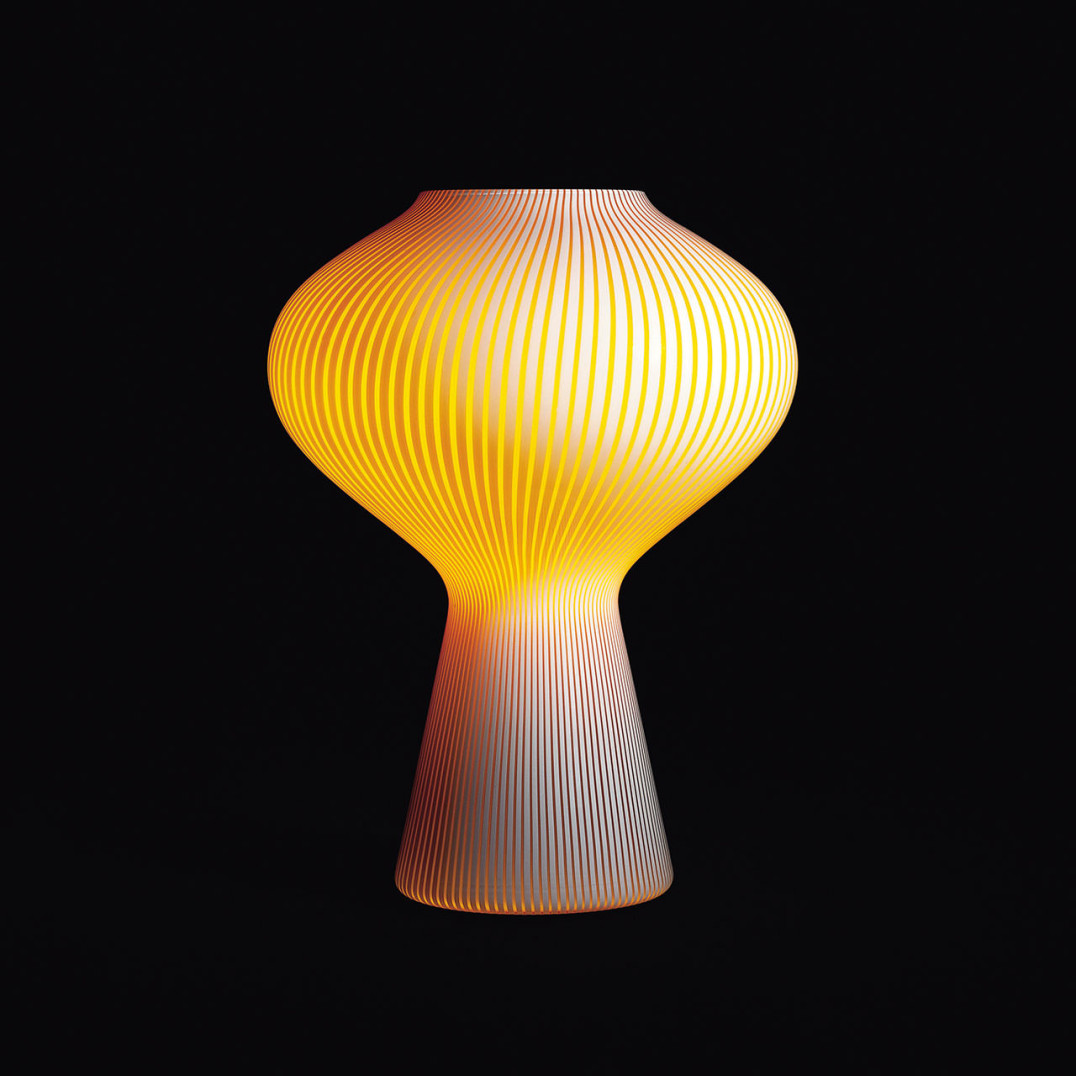
Massimo VignelliFungo, 1955
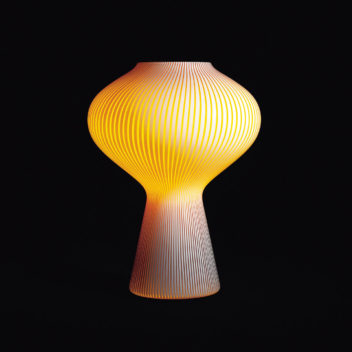
Massimo VignelliFungoVenini & C., 1955
Table lamp in the shape of a mushroom crafted with lattimo and yellow glass canes. The architect, Massimo Vignelli, received an honorable mention at the Compasso d’Oro in 1956 for this design.
13 3/4 in. high (35 cm)
Exhibitions:
2000, New York, Venetian Glass, Museum of Arts & Design;
2001, Milan, Murano: Vetri dalla Collezione Olnick Spanu, Spazio Oberdan.
Bibliography and comparative texts:
Stile Industria, 1956, December, n. 9;
Design Vignelli, 1990, p. 262;
Designed for Delight, 1997, n. 133;
R. Barovier Mentasti, 1998, n. 156;
M. Romanelli, 2000, p. 209;
A. Venini Diaz de Santillana, 2000, n. 228; Olnick Spanu, 2000, n. 102;
Olnick Spanu, 2001, n. 139.

Massimo Vignelli 1931–2014
Massimo Vignelli studied architecture in Milan and Venice. While in Venice as a student, he worked for Venini from 1953 to 1957, designing lighting fixtures, glass windows, drinking glasses, and pitchers. Most of the pieces he designed are today in museum collections, notably the Museum of Modern Art and the Metropolitan Museum of Art in New York, the Musée des Arts Décoratifs in Montreal, Die Neue Sammlung in Munich, and others. A monographic exhibition of the Vignellis' work toured Europe between 1989 and 1993. Over the course of his career, Vignelli worked across the field of design, from graphic identity programs to publications, from products in glass, china, silver, and plastic to furniture and interiors. His work has been widely recognized by museums, publications and exhibitions throughout the world. Among Vignelli's impressive awards are the Gran Premio Triennale di Milano, 1964; Compasso d'Oro, 1964 and 1998; the AIA 1973 Industrial Arts Medal; the Art Directors Club 1982 Hall of Fame; the 1983 AIGA Gold Medal; the first Presidential Design Award; the Interior Design Hall of Fame, 1988; the National Arts Club Gold Medal for Design, 1991; the Interior Product Designers Fellowship of Excellence, 1992; and the Brooklyn Museum Design Award for Lifetime Achievement, 1995. He was awarded an Honorary Doctorate in Architecture from the University of Venice, Italy, and Honorary Doctorates in Fine Arts from Parsons School of Design, Pratt Institute, Rhode Island School of Design, and Corcoran School of Art. In 1996 he received the Honorary Royal Designer for Industry Award from the Royal Society of Arts, London.

Venini & C. 1932–2001
In 1932, when both Martinuzzi and Zecchin left the company, Paolo Venini changed the name from Vetri Soffiati Muranesi Venini & Co. (V.S.M. Venini & Co.) to Venini & C.. Milanese architect Tommaso Buzzi became the new artistic director. After 1934, artistic direction was taken on by Carlo Scarpa, who designed most of the company's production through 1947. Side by side with Venini, who often intervened personally in design, Scarpa created numerous collections of objects characterized by refined colors. After World War II, Venini & C. sought numerous collaborations with artists such as architect Giò Ponti and the Swedish-born Tyra Lundgren. After 1948, Fulvio Bianconi, Massimo Vignelli, and Tobia Scarpa contributed significantly to the new direction of the company. Paolo Venini died in 1959 and his son-in-law, Ludovico Diaz de Santillana, took over the management of Venini & C. He not only worked personally as a glass designer but also continued the collaboration started by Paolo Venini with various artists and designers. Starting in 1960, many other designers collaborated with the company, like Thomas Stearns, Toni Zuccheri, Tapio Wirkkala, Laura and Alessandro Diaz de Santillana, James Carpenter, Dan Dailey, Richard Marquis, Benjamin Moore, and Toots Zynsky. In 1986, the de Santillana family left the company, selling their stock to the Ferruzzi group, which guaranteed the fine quality Venini was known for by hiring new designers such as Timo Sarpaneva, Marco Zanini, Ettore Sottsass Jr., Alessandro Mendini, Mario Bellini, Barbara del Vicario, and others. In 1988, Venini was acquired by Royal Scandinavian. Since 2001, Venini S.p.A. has been part of Italian Luxury Industries Group and is led by Giancarlo Chimento, Giuliano Tabacchi, and Giorgio Rizzo.